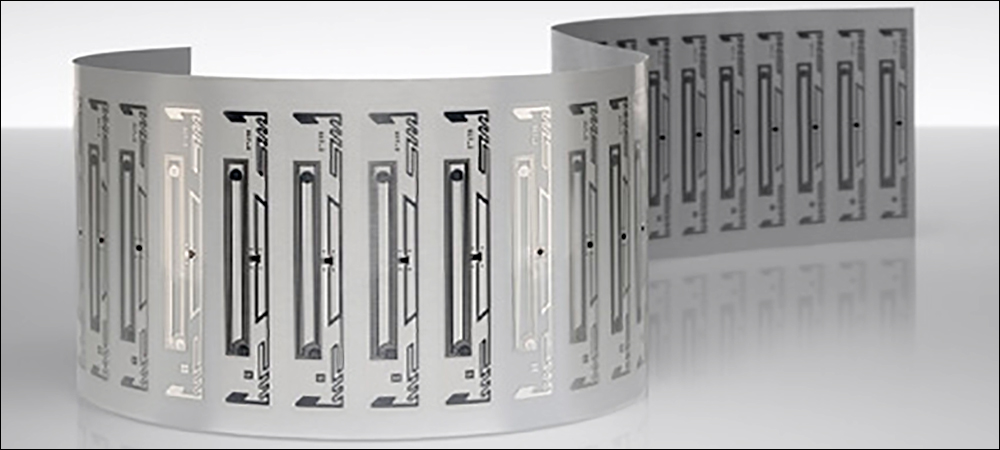- Providing Access to RTI Data
- Analytics Across a Product’s Lifespan
- Labels and Solutions Aimed at Sustainability
Several businesses are deploying a dual-frequency label from Avery Dennison Smartrac, featuring both UHF RFID and Near Field Communication (NFC), to enable inventory and supply chain management, consumer engagement and related analytics with a single tag. UHF RFID readers can interrogate the company’s AD Slim DF EM4425 tag and inlay at a relatively long distance (in a warehouse, for instance), and consumers can access the data using a smartphone via NFC at short range.
When the inlay and tag are used with Avery Dennison’s atma.io software, businesses can capture analytics about tagged items throughout their lifespan, based on NFC and UHF RFID tag reads. The company released the AD Slim DF EM4425 this summer for use in item-level tagging for brands or pharmaceuticals, as well as for industrial products and returnable assets. It leverages EM Microelectronic‘s Echo-V dual-frequency chip, released in 2020, which can receive and transmit data via both the NFC or HF (compliant with either ISO 14443 or ISO 15693) and UHF RFID frequencies.

The AD Slim DF EM4425
In the case of consumer products or apparel, the tags can be used throughout a product’s lifespan as it moves through the supply chain to a consumer, after it has arrived at that person’s home, and as it is recycled or discarded. Interactions with the product before, during and after purchase, whether in-store or at home, can then be captured and analyzed by the cloud-based atma.io software.
The AD Slim tag is designed to be thinner and more discrete than other tags on the market, Avery Dennison reports, making it easier to apply to goods in a price label or attached to the side of returnable assets. The company designed an antenna measuring 74.2 millimeters by 10.7 millimeters (2.9 inches by 0.4 inch) to accomplish its relatively small size.
Both the inlay and tag are available in wet-delivery format (with adhesive). At the center of the product is the EM4425 V12 Echo-V IC with 2,048 bits of shared user memory, which is accessible via UHF RFID and NFC frequencies. It typically transmits at a distance of up to 10 meters (32.8 feet) with a UHF RFID-based interrogation, and up to 2 inches via NFC taps from a smartphone. Avery Dennison Smartrac designed the dual-frequency tag to serve several key applications, according to Max Winograd, the company’s VP of connected products.
When it comes to consumer brands and apparel, as well as pharmaceutical products, some businesses are already using UHF RFID tags to automatically identify goods as they pass through warehouses, change custody or enter a retailer’s back room. However, product data is not readily available to consumers who engage with items in a store or after taking them home. The only RFID reader available to consumers is the NFC radio built into their smartphone. Therefore, some companies are applying NFC tags to products to provide authentication, content and interactions to those who tap their phone against the tags. With the AD Slim, both applications can be accomplished with the same tag.
Providing Access to RTI Data
There are a variety of applications for the dual-frequency tag beyond consumer products and apparel, Winograd says. For instance, the tags could track returnable transport items (RTIs), such as roll cages or plastic pallets on which products are transported. In such a use case, the UHF RFID tag functionality would be used in warehouses or during the loading of goods, if a company deployed fixed RFID reader gates or used dedicated handheld readers. The RTIs are often delivered to businesses that do not have RFID readers, however.
In that case, those companies or their customers could use their own smartphones to access data and thereby update the status of the RTIs and the goods on them. For instance, if a bar or a food service provider were to receive a tagged, returnable beer keg, it could authenticate it and create another data point about when that keg was received or returned. The RTI’s owner could view that data for status updates and track its movement long after it left the owner’s own facility. By providing greater transparency and visibility regarding RTIs, Winograd explains, the technology provides “better trust on the part of both the shipper and the company that receives the goods.”
For multiple potential applications, the company reports, the new product is expected to reduce costs for technology users since it requires less material than using two individual tags, and because it provides more functionality in a single form factor. The tag’s size is key as well, Winograd says, adding, “We focused on really trying to help with reducing the form factor of the inlay for applications on things like cardboard… The end goal is a consistent customer experience, regardless of channel.”
Analytics Across a Product’s Lifespan
The tag provides analytics when used with the atma.io software, Winograd explains. The platform was released last year to provide cloud-based data access, along with analytics. Each product comes with a single unique digital ID number, and data about that item that is stored in the cloud. Each subsequent read event is then stored in the system as well, thus providing what Winograd calls another layer of intelligence and visibility based on those read events.
Some common use cases include analyzing when, where and how often goods are shipped, for the purpose of analyzing shipping trends. That data could be used to drive sustainability and greater efficiency, Winograd says, by identifying ways in which goods could be shipped more effectively, such as reducing excess driving by delivery vehicles or ensuring a vehicle is full before it begins its journey to a customer site. This provides users with carbon footprint validation, he notes, and that sustainability data could be shared with interested consumers.
Information also includes the identification of which distribution sites have the longest dwell times for products, as well as when and where product demand increases. Atma.io can inform shippers when products should be packed and transported, and it can make recommendations based on expiration dates. Once a product is transported to a store and the same tag is engaged with by consumers, a brand owner can obtain atma.io analytics indicating how, where and when such engagement occurs.
Labels and Solutions Aimed at Sustainability
The collected data can inform consumers about how a particular product was made, in addition to a company’s sustainability record, and thus help to build loyalty, Winograd says. The solution enables consumers to capture data about recycling or other safe disposal methods, allowing them to play a role in the circular economy and sustainability.
The latest version of atma.io was released this past spring, which includes a waste-elimination tool. With that tool, companies can not only guide consumers to recycling sites via NFC-based content, but also track how many items are properly recycled, as long as the RFID tags are read at that location. “We’re continuing to extend what the platform can do,” Winograd states, “so that brands can get more and more out of connected products.” In the long term, he says, the goal is to provide traceability from raw materials all the way through the consumer use of a product.
The AD Slim is the latest product to result from an active development period for Avery Dennison Smartrac, Winograd reports. The company continues to develop products based on new customer demands, and he forecasts that future offerings will provide a combination of ways to make technology adoption more affordable, as well as more intelligent, with sensors and other functionalities.
Key Takeaways:
- Companies that deploy the AD Slim inlay or tag are capturing automatic data across the supply chain via UHF readers, then extending items’ visibility with NFC functionality for consumers or others with NFC-enabled phones.
- The tag and the atma.io software platform are aimed at a variety of applications, ranging from retail traceability and engagement to pharmaceuticals management and the tracking of returnable transport items to businesses lacking UHF RFID readers.


